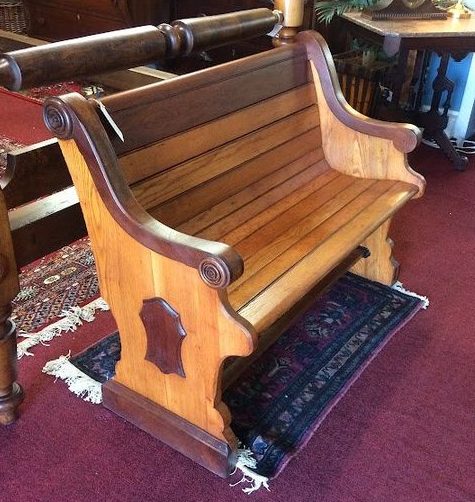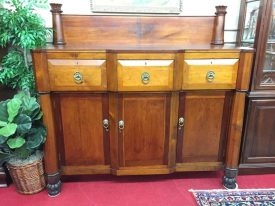Step inside any historic church, and you’ll likely find rows of sturdy and iconic pews, quietly holding the weight of history. But over time, these cherished pieces of furniture can begin to show signs of wear and tear.
That’s when the art of restoring church pews comes to the rescue, preserving history while embracing the future.
Restoring church pews is much more than simply repairing or refurbishing them. It’s an intricate process that involves a deep understanding of both the craftsmanship and the historical significance of each piece. From meticulously sanding away decades of accumulated wear to carefully reupholstering with fabrics that mirror the original design, every step is a labor of love.
By restoring church pews, we not only breathe new life into these hallowed seats but also ensure that future
generations can experience the ambiance and authenticity of these historic spaces. It’s a delicate balance between preservation and adaptation, honoring the past while making room for the needs of modern congregations.
So next time you find yourself sitting in a beautifully restored church pew, take a moment to appreciate the artistry behind it. Through skilled hands and a commitment to preserving history, these pieces continue to serve as a bridge between the past and the future.
The significance of church pews in historical churches
Church pews have always played a crucial role in the architecture and design of historical churches. These wooden benches not only provide seating for the congregation but also serve as a symbol of unity and reverence. The design and craftsmanship of church pews often reflect the artistic style of the era in which they were built, making them valuable artifacts that tell a story of the past.
Moreover, these pews have witnessed countless sermons, prayers, and significant events throughout history. They have provided a place of solace and reflection for generations of worshipers. Restoring church pews allows us to honor the legacy of these sacred spaces and preserve their historical significance for future generations.
Understanding the restoration process for church pews
Restoring church pews is an intricate process that requires a deep understanding of the original craftsmanship and historical significance of each piece. It begins with a meticulous assessment of the condition of the pews, identifying areas that need repair or replacement. This may include damaged wood, loose joints, or worn-out upholstery.
The restoration process typically involves stripping away layers of old paint or varnish to reveal the natural beauty of the wood. This is followed by sanding and smoothing the surfaces to remove any imperfections or signs of wear. Skilled craftsmen then carefully match and replace any missing or damaged parts, ensuring that the restored pew maintains its original design and structural integrity.
Choosing the right materials for restoring church pews
When it comes to restoring church pews, selecting the right materials is crucial to maintaining their authenticity and longevity. The choice of wood for replacement parts should closely match the original, both in terms of species and grain pattern. This ensures a seamless integration of new components with the existing structure.
For upholstery, it is essential to use fabrics that mirror the original design while also meeting modern standards of durability and comfort. Church pews often feature intricate patterns and motifs that may require custom-made fabrics to achieve an accurate restoration. By paying attention to these details, we can create a finished product that not only looks authentic but also stands the test of time.
Step-by-step guide to restoring church pews
Restoring church pews requires a systematic approach to ensure a successful outcome. Here’s a step-by-step guide to the restoration process:
1. Assessment: Begin by thoroughly inspecting the pews, noting any damage or areas that require attention. This will help create a comprehensive restoration plan.
2. Stripping: Remove any existing paint, varnish, or finish from the pews using appropriate methods such as sanding, scraping, or chemical stripping. This will expose the raw wood surface.
3. Repair: Address any structural issues by repairing or replacing damaged wood, loose joints, or other components. This step may involve skilled woodworking techniques to ensure a seamless repair.
4. Sanding and smoothing: Use a combination of hand sanding and power sanding tools to smooth the surfaces and remove imperfections. This will create a clean canvas for the next steps.
5. Finishing: Apply a suitable finish to protect the wood and enhance its natural beauty. This may involve staining, varnishing, or painting, depending on the desired outcome and the historical context of the pews.
6. Upholstery: Reupholster the pews using fabrics that closely match the original design. This step requires careful attention to detail to ensure a precise fit and a professional finish.
7. Final touches: Install any additional decorative elements or accessories that were part of the original design, such as pew ends or kneelers. These details add to the overall authenticity of the restored pews.
By following these steps with precision and expertise, we can bring old and worn-out church pews back to life, ensuring their continued use and appreciation for years to come.
Maintaining and preserving restored church pews
Once church pews have been successfully restored, proper maintenance is essential to preserve their beauty and functionality. Regular cleaning using gentle methods and non-abrasive materials will help remove dust and prevent the buildup of dirt or grime. It is important to avoid using harsh chemicals or abrasive cleaners that could damage the finish or upholstery.
Additionally, it is advisable to periodically inspect the restored pews for any signs of wear or damage. Promptly addressing any issues can prevent further deterioration and the need for extensive repairs in the future. Engaging the services of professional restorers for regular maintenance can help ensure that the pews remain in optimal condition.
Incorporating modern elements into restored church pews
While the goal of restoring church pews is to preserve their historical significance, there is also room for incorporating modern elements that enhance their functionality and comfort. For example, adding cushioning to the seating surface or providing ergonomic support can improve the overall experience for worshipers.
It is important, however, to strike a balance between modernization and preservation. Any modifications should be reversible and respectful of the original design and craftsmanship. This allows for adaptability without compromising the authenticity of the restored church pews.
Examples of successful church pew restorations
Across the world, numerous successful church pew restorations have breathed new life into these historic spaces. One such example is the restoration of the pews at St. Paul’s Cathedral in London, where damaged wood was meticulously repaired, and the original upholstery fabrics were recreated to match the original design. The result is a stunning restoration that honors the historical significance of the cathedral while providing a comfortable seating experience for worshipers.
Another notable example is the restoration of the pews at the Notre-Dame Basilica in Montreal, Canada. The project involved a comprehensive restoration of the pews, including repairing damaged wood and replacing worn-out upholstery. The restored pews now serve as a testament to the rich history of the basilica, welcoming visitors from around the world.
Hiring a professional for church pew restoration
Due to the intricate nature of church pew restoration, it is highly recommended to hire a professional with expertise in this field. Professional restorers have the knowledge, skills, and specialized tools required to handle the delicate process of restoring church pews. They understand the historical significance of these pieces and can ensure that the restoration is carried out with utmost care and attention to detail.
When selecting a professional for church pew restoration, it is important to consider their experience, portfolio, and references. A reputable restorer will provide a comprehensive assessment of the pews, a clear restoration plan, and a transparent cost estimate. By entrusting the restoration to a professional, you can have confidence in the quality of the work and the preservation of the pews’ historical value.
The cost of restoring church pews
The cost of restoring church pews can vary depending on several factors, including the extent of the damage, the complexity of the restoration, and the materials used. Each project is unique, and it is essential to consult with a professional restorer to obtain an accurate cost estimate based on the specific requirements.
While the cost of restoration may initially seem significant, it is important to consider the long-term benefits and value that restored church pews bring to historical churches. By investing in restoration, we ensure the preservation of these significant artifacts for future generations to appreciate and enjoy.
Preserving the legacy of church pews for future generations
Restoring church pews is not just about repairing furniture; it is a labor of love and a commitment to preserving history for future generations. By breathing new life into these hallowed seats, we ensure that the ambiance and authenticity of historical churches are maintained.
Restored church pews serve as a bridge between the past and the future, allowing us to experience the beauty and significance of these sacred spaces. Through skilled hands and a dedication to preserving history, we can ensure that the legacy of church pews continues to inspire and enrich the lives of worshipers for years to come.
So next time you find yourself sitting in a beautifully restored church pew, take a moment to appreciate the artistry behind it. From the careful restoration process to the preservation of historical significance, these pieces are a testament to the craftsmanship of the past and the enduring spirit of faith.








